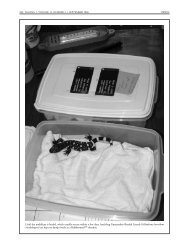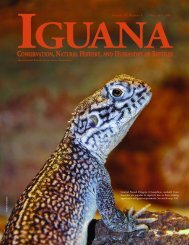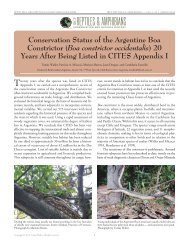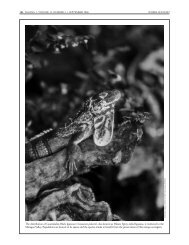Spiny-tailed Iguanas (Ctenosaura similis) in Venezuela
Spiny-tailed Iguanas (Ctenosaura similis) in Venezuela
Spiny-tailed Iguanas (Ctenosaura similis) in Venezuela
You also want an ePaper? Increase the reach of your titles
YUMPU automatically turns print PDFs into web optimized ePapers that Google loves.
ROBERT POWELL<br />
136 IGUANA • VOLUME 15, NUMBER 3 • SEPTEMBER 2008 DANIELLS ET AL.<br />
woodland from sea level to elevations of ~900 m. Populations<br />
are quite variable on different parts of the island. Once considered<br />
to be subspecies, these color variants now usually are treated<br />
as ecotypes (populations with habitat-specific color and pattern<br />
adaptations). Ground color may range from light to dark brown,<br />
although <strong>in</strong>dividuals <strong>in</strong> upland forests may be dark green.<br />
Females usually are unicolored or have a few black and beige<br />
spots. Males are more dist<strong>in</strong>ctive, rang<strong>in</strong>g from largely unicolored<br />
animals with a few light specks to those hav<strong>in</strong>g prom<strong>in</strong>ent<br />
black and beige spots. These sit-and-wait foragers eat small<br />
arthropods, and may <strong>in</strong> some <strong>in</strong>stances “specialize” <strong>in</strong> concentrated<br />
resources such as social <strong>in</strong>sects (e.g., ants and termites).<br />
They may occasionally consume plant material, <strong>in</strong>clud<strong>in</strong>g the<br />
pulp of fallen mangos. Although primarily diurnal, like many<br />
other West Indian anoles, A. oculatus readily exploits <strong>in</strong>sects<br />
attracted to lights at night. The conservation status of these<br />
lizards has not been assessed, but at least some populations are<br />
vulnerable to displacement by A. cristatellus.<br />
Mabuya mabouya (Lacépède 1788). Squamata: Sc<strong>in</strong>cidae. Local<br />
names: Kléwant, Zanndoli Kléwant, Soud. English common<br />
name: Lesser Antillean Sk<strong>in</strong>k. Native; however, the taxonomic<br />
status of West Indian populations currently assigned to the<br />
genus Mabuya is poorly resolved, and populations on each island<br />
bank should be considered endemic to that bank until de<strong>tailed</strong><br />
studies have been conducted. These diurnally active lizards<br />
(maximum male SVL 87 mm, maximum female SVL 93 mm)<br />
occur <strong>in</strong> dry coastal woodlands, littoral woodland, dry shrubs,<br />
and coconut plantations, where they occupy leaf litter and take<br />
refuge <strong>in</strong> holes <strong>in</strong> trees and stumps or <strong>in</strong> and under boulders.<br />
Sk<strong>in</strong>ks are sh<strong>in</strong>y, with very smooth scales. Ground color is<br />
bronze or coppery, with a cream-bordered darker brown band<br />
on each side and very dark brown or black specks on the back.<br />
These lizards bear live young that are very large compared to<br />
maternal size. The conservation status of this species has not<br />
been assessed.<br />
Gymnophthalmus pleii (Bocourt 1881). Squamata:<br />
Gymnophthalmidae. No local name. English common names:<br />
Rough-scaled Worm Lizard, Keeled-scaled Worm Lizard.<br />
Lesser Antillean endemic; the subspecies G. p. pleii occurs on<br />
Mart<strong>in</strong>ique, Dom<strong>in</strong>ica, and Guadeloupe, other subspecies occur<br />
Like their relatives, Rough-scaled Worm Lizards (Gymnophthalmus<br />
pleii) occur primarily <strong>in</strong> leaf litter, where they are adept at “swimm<strong>in</strong>g”<br />
through the leaves, mak<strong>in</strong>g them difficult to f<strong>in</strong>d and study.<br />
The taxonomic status of West Indian populations currently assigned to the Lesser Antillean Sk<strong>in</strong>k (Mabuya mabouya) is poorly resolved, and populations<br />
on each island bank should be considered endemic to that bank until de<strong>tailed</strong> studies have been conducted.<br />
ROBERT POWELL








